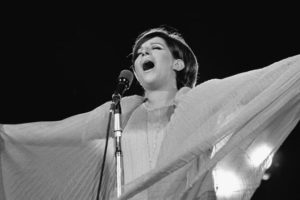

In the above linked piece, you will note that there is some little concern over the fact that the Met’s level of potential box-office revenue has fallen to 66%, which apparently is some kind of magical warning number that means that things have gone terribly, terribly wrong. La Cieca isn’t sure she agrees with this assessment, because there are some kinds of theaters that sell out practically every night of the week presenting, more often than not, underrehearsed undercast crap and there are other theaters that present wonderful opera that doesn’t sell.
But that’s not the assignment here. The question is, “How Can [The Met] Fill Those Empty Seats?” and La Cieca will now address this issue directly.
There are obviously artistic approaches that can be taken: more “event” type programming, including limited-run concert operas featuring A-list stars. The idea of shorter programs, at least on weeknights, is one that could be explored. (Is there any reason why Meistersinger has to play on a Tuesday, for example?) And I am 100% behind the idea of trying to market opera as a type of avant-garde theater to people who like that sort of thing.
La Cieca, though, will take the question literally. Let’s get some butts into those seats.
The answer, it seems to be, is a refinement and great expansion of the existing Rush Ticket program (as originally backed by the sainted Agnes Varis.)
In perusing the online ticketing forms on the Met’s website this season, La Cieca has noticed a curious pattern regarding weekday sales. The highest priced tickets (Orchestra Prime and Center Parterre) and the cheapest seats (Balcony and Family Circle) tend sell strongly. But midpriced tickets (Rear Orchestra, Non-Premium Grand Tier and Dress Circle) don’t move very well. There seems to be something about the just over $100 range that just doesn’t appeal, for whatever reason. Those unsold tickets end up representing a major chunk of the missing 34% the NYT is so jittery about.
So why not just take most of those tickets off the general market and earmark them for rush-type sales? The first effect would be vastly to increase demand for the remaining tickets in that price range. The second would be to give the target audience for rush tickets the treat of seeing and hearing the opera from rather a good vantage point.
Now comes some math, so take a deep breath. Let us begin with the Dress Circle. This section is currently sold in five segments, but for the purposes of this argument we’re going to focus on the lower-priced “Non-Premium”sections, which are the slow sellers to the sides and back. The average ticket price on a weeknight for the Non-Premium Dress Circle is about $110, and there are 244 seats in that section. During a 32 week season there are around 120 weeknight performances (allowing for some dark nights.)
So (multiplying) if one were to buy all the Non-Premium Dress Circle tickets for the entire season (Monday through Thursday nights only), that would cost about $3.2 million. Then the Met could resell them as rush tickets for, say, $35, and assuming all the tickets sold (which they should, at a discount of more than 60%!) that would generate about a million dollars in revenue across the season. So, subtracting, the total subsidy for a season’s worth of Dress Circle rush tickets would be in the vicinity of $2.2 million.
That is not a huge amount of money for at least a few of the extremely wealthy members of the Met Board and those who aspire to joining that group, particularly if the Met positions this rush ticket program as the “Mamie Glutz Rush Ticket Program.” For that $2 mil and change, Mme. Glutz will be able to preen herself on facilitating the attendance at the Met of something around 29,000 eager opera lovers.
That figure would be also chickenfeed for a corporate sponsor, but we’ll return to that idea in a moment.
Similar programs in Grand Tier and Rear Orchestra (at different levels of pricing) could boost the nightly increase in audience to as much as 600, which across the season would mean a boost in both attendance and in potential box-office revenue of around 9%. So, in other words, if this program were to succeed completely, the Met’s attendance would stand at about 80% and the box office potential circa 75%.
Now, attractive as that bump is, it’s a short-range fix. Obviously if for whatever reason the box office were to start booming, the rush ticket program would need to be scaled down or phased out. But while it’s in place we should make sure it does the most good.
The motivation for distributing rush ticket should and must be developing the audience, which means narrowly focusing both on the young (e.g., students) and the youngish (e.g., under-40 professionals residing in and near New York City.) So the method of distribution should be fine-tuned to these groups.
The current online “rush” application is all right so far as it goes, and I would say that some portion of the allotted tickets should still be distributed by this means. But there are other more targeted methods I would propose as well.
For the “cream” of the potential attendees, those with some little discretionary income and a demonstrated desire to attend the opera multiple times in a season, how about setting up a membership (possibly with a fee) that allows members first choice of the rush tickets sold on the day? A member could fill out an online form expressing interest in a particular opera, a day or days of the week, or even a particular performance he wished to attend. The day before the tickets for that desired event were to be released generally, the member would receive a notification via text or email that a pair of tickets was available for purchase for a limited amount of time, say until midnight that night. The user would simply respond “YES” and the tickets would be assigned, charged to a credit card on file, and then, according to the preference the user expressed at the time of joining, the tickets would be held at the will-call or sent electronically.
There could be another text/email blast going out to those who registered online for a given day’s performance, offering remaining tickets and even a choice of locations and prices. Again, these tickets would be paid for by credit cards on file and made available to the audience member electronically or else at the will-call.
A cheaper block of tickets could be held at the box office for a daily real-time queue: hopefuls could line up outside the Met beginning at say 4:00 PM for a 6:00 PM distribution of that evening’s offering. The physical queue would have the added benefit of making the Met look busy and in-demand just before performance time, a useful psychological prod to potential audience members on the fence about buying tickets.)
For those who missed out on a given evening’s tickets, the Met could follow up with a message thanking them for their interest and reminding them that the next performances of La bohème will be on November 14 and 18, at prices beginning at $35, and do keep in mind that the Met is also currently presenting Die Frau ohne Schatten and Carmen on the following dates.
Again, the highest priority would be to target students and young professionals. There would obviously have to be a small block of tickets held back for seniors or you’d never hear the end of it, but I would say that block needs to be kept quite small. The long-range purpose of this program is to get young audiences into the habit of going to the opera.
A corollary program might involve compiling and analyzing data for each potential rush ticket buyer across the season. How often did they try to get tickets and miss out? What attractions did they most want to attend, and did they succeed? These data could even be rolled over into a late-season subscription offer: here are all the operas you wanted to see but missed this season, and here are the most mouth-watering offerings for next. Don’t you think it would be worth not so very much more money to commit now to, say, these five nights (or five nights of your choosing) next season? (The stock for these subscription offers—again made exclusively to The Youth—could be culled from the following season’s potential rush tickets.)
Meanwhile, the Met can gather a vast assortment of information about these potential new audience members, both en masse and individually. So when it comes time to market a new attraction, the company can proceed armed with knowledge.
Now, backtracking a bit: who exactly is going to pay for the “subsidy” here. As I mentioned before, it would be an attractive project for one or more Board members or potential Board members to take on. But maybe even more intriguing is the idea of corporate sponsorship: The Uniqlo Metropolitan Opera Dress Circle Rush Ticket Program! Physical and electronic tickets could carry the sponsor’s branding, and the stubs might serve as coupons offering discounts on the sponsor’s product. I don’t see, in fact, why the sponsor should not be invited to set up a display in the lobby area of the level they support, offering samples (The Shake Shack Metropolitan Opera Grand Tier Rush Ticket Program!) or, perhaps more realistically, a branded informational kiosk.
Now, obviously such a program would have to be rolled out gradually. There is no guarantee, for example, that the market could absorb 600 rush tickets every night for four nights a week, and there would probably have to be tweaks to accommodate visitors to New York. But if we want to see the Met full again, the company needs to start treating unsold tickets as an asset instead of an embarrassment.























Comments